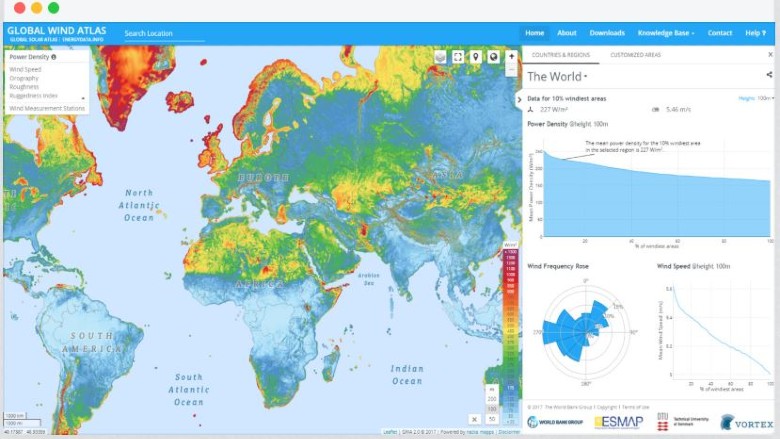Challenge
Understanding the scale and geographical spread of RE resources at a country level was a crucial prerequisite for governments and regulators to properly plan and support investments in power generation from renewable energy resources, including associated investments in transmission, distribution and power storage, and power system planning. For commercial developers, gaining access to high quality public data on renewable energy resource potential would help lower barriers to entry, reduce the time requirement for project identification and preparation, and improve the certainty behind power yield estimates, reducing the cost of project finance. When this initiative was conceived, most developing countries had very limited public data on renewable energy resource potential. This hampered development of renewable energy resulting in policy uncertainty, poorly informed power off-takers, and higher risks for investors.
Approach
To address these challenges, the ESMAP launched a new global initiative to support resource assessment and mapping activities globally and at the country level. Global activities included the development of Global Solar Atlas (GSA) and Global Wind Atlas (GWA) and global resource datasets, maps and geospatial data layers for public dissemination, and web-based tools for data analytics. The program also included technical and financial support from the global team to country-level activities, including detailed resource assessment and mapping studies, ground-based measurement campaigns, geospatial planning, and related work to support renewable energy development. The ESMAP global team provided in-country teams with expert advice, standardized terms of reference, facilitated procurement, access to global data hosting solutions, and coordination with external stakeholders and donors.
Results
The development of the GSAs and the GWA has been a major success for ESMAP and the World Bank Group, helping to provide critical information on solar and wind resource potential to our clients, task teams, and development partners while also raising the profile of the institution on renewable energy and as a provider of critical "global public goods".
In June 2020, monthly usage of the GSA and GWA stood at 23,000 and 15,000 unique users, respectively. For GSA, 66 percent of unique users are new users, with WBG client countries representing 13 of the top 25 users by country (with Brazil and Vietnam the top two user categories, respectively). Around 9 percent of users download a poster map while the website "bounce rate" (percentage of users who do not interact upon landing on the website) is a relatively low at 18 percent. However, the success of the GSA goes beyond the website. The poster maps have been used by WBG operational teams to facilitate client engagement on solar power, and the GIS layers have been used in more detailed follow-on analysis - for example to identify solar and wind zones within a country. For example, the solar mapping data was used to prepare the feasibility study for the first 50 MW solar power plant under the Sindh Solar Energy Project in Pakistan, approved by the Board in June 2018. More recently data from the GSA has enabled a mapping of rooftop solar potential in over 12 client country cities (ongoing), and May 2020 data from the GWA was used to estimate an offshore wind potential of over 15.6 Terawatts in 48 client countries.
In addition, to the impressive growth in user numbers for GWA, the underlying data has been utilized in numerous ESMAP-funded technical assistance projects, including for Afghanistan, Algeria, Botswana, Burkina Faso, Central African Republic, Cote d'Ivoire, Democratic Republic of Congo, Ethiopia, Gambia, Indonesia, Kenya, Liberia, Mali, Nicaragua, Niger, Mongolia, Myanmar, Namibia, Pakistan, Papua New Guinea, Philippines, Senegal, Somalia, Sudan, Tunisia, Turkey, Ukraine, Ukraine, Uzbekistan, Vietnam, and Zimbabwe.
In addition to the GSA and GWA, the program supported scale-up of power generation from RE sources through resource assessment and mapping activities globally and in the following countries: Indonesia, Madagascar, Malawi, Maldives, Papua New Guinea, Vietnam, Tanzania, Pakistan, Zambia, Lao PDR. The program provided technical support to country-level activities, including detailed resource assessment and mapping studies, ground-based measurement campaigns and geospatial planning. For example, the geospatial data and maps from the resources mapping exercise have been very influential in Vietnam. The data is routinely used by both planning teams at the Ministry of Industry and Trade and private developers, contributing to the growth of the solar market in the country (over 5GW capacity added in 2019-2020). In addition, Electricity Vietnam (EVN) – the main counterpart utility – is in the process of linking the GIS data hosted by the World Bank to its online solar portal which massively improves the mainstreaming of high-quality digital data for renewable energy development.
Bank Group Contribution
The ESMAP support in FY17-20 for RE Mapping Initiative accounted for $7 million, including $4 million provided for country grants.
Partners
The project has partnered with International Finance Corporation (IFC) in using the measurement results to promote RE development through WBG “Scaling Solar” projects in Armenia, Ethiopia, Madagascar, Senegal and Zambia. The partnership with IFC also included the work on mapping of rooftop solar PV potential in multiple cities.
In development of the Global Wind Atlas (GWA) the project partnered with the Wind Energy Department at the Technical University of Denmark (DTU Wind Energy), which had developed the first version of the atlas, and was substantially improved and co-branded under this project via the partnership between ESMAP and DTU Wind Energy. The initiative also worked closely with the International Renewable Energy Agency (IRENA) to provide access to all generated datasets and maps via their Global Atlas for Renewable Energy.
Moving Forward
The future development and maintenance of the GSA and GWA have been transferred to a broader ESMAP-supported initiative, the Energy Data Hub, under the ESMAP Business Plan for FY21-24. The knowledge generated under this program will also directly feed into additional ESMAP programs going forward, and the country activities that they in turn support: Energizing Renewables, Innovative Solar and Offshore Wind Development Program.
Beneficiaries
The program beneficiaries include clients and development partners who are implementing resource assessment and mapping projects with or without WBG involvement.
